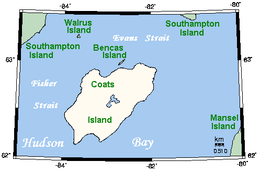Coats Island
| Native name: Akpatordjuark | |
|---|---|

Coats Island, Nunavut
|
|
 |
|
| Geography | |
| Location | Hudson Bay |
| Coordinates | 62°35′N 082°45′W / 62.583°N 82.750°WCoordinates: 62°35′N 082°45′W / 62.583°N 82.750°W |
| Area | 5,498 km2 (2,123 sq mi) |
| Highest point | 185 m (607 ft) |
| Administration | |
| Nunavut | Nunavut |
| Region | Kivalliq |
| Demographics | |
| Population | Uninhabited |
Coats Island (Inuktitut: Akpatordjuark) lies at the northern end of Hudson Bay in the Kivalliq Region of Nunavut. At 5,498 km2 (2,123 sq mi) in size, it is the 107th largest island in the world, and Canada's 24th largest island.
The island has areas of federal crown land and areas of private land owned by Inuit, however, the last permanent residents left in the 1970s. With no permanent settlements, the island is also the largest uninhabited island in the northern hemisphere south of the Arctic Circle. It was the last home of the Sadlermiut people who are widely believed to represent the Dorset culture.
Coats Island is 130 km (81 mi) long. It reaches a maximum elevation of 185 m above sea level. This high point occurs along the rocky northern perimeter between Cape Pembroke and Cape Prefontaine. The underlying rocks in this area are Precambrian metamorphics. Less than 5% of the island is more than 100 m (330 ft) above sea level. The southern half of the island is primarily low-lying muskeg and made up of Palaeozoic sedimentary rocks, such as limestone and sandstone.
Since 1920, Coats Island has been designated a caribou reserve. After caribou were extirpated from nearby Southampton Island, the Coats herd was used to re-establish the Southampton herd. It is also known for its population of thick-billed murre. Two colonies of 30,000 birds occur along the cliffs at the rocky northern end. There are also significant concentrations of walrus at walrus haulouts at the base of cliffs or on offshore islands at the northern end of the island (one each at Cape Pembroke and Cape Prefontaine). These are visited regularly by Inuit from the hamlet at Coral Harbour, on Southampton Island, for harvesting.
Cape Pembroke is an Important Bird Area.
...
Wikipedia
